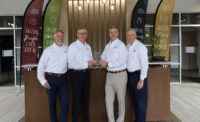Common lore holds that 66 years ago the first television commercial aired in the United States (“America runs on Bulova time!”), but the difficulty to develop advertising and marketing that connects well with target consumers has grown exponentially.
Two years ago, Brenda Barnes, Sara Lee Corp. chairman/CEO, announced a plan to transform the entire corporation into a focused, integrated consumer-products company — no small feat for a what is now a $7 billion food business.
Today, Sara Lee’s Food & Beverage division has taken both challenges and run with them, working its way through the rigors of the transformation with a nimble step and pumping out innovative, popular products using deep-seated insights without flinching.
Furthermore, Sara Lee Food & Beverage has unveiled a more focused, aggressive marketing campaign for each of its mega-brands and has begun work on a 150,000-square-foot centralized R&D facility.
With the transformation mostly in its rear-view mirror and an expert team of innovators and thought leaders on its side, Sara Lee Food & Beverage has earned The National Provisioner’s 2007 Processor of the Year Award. Its commitment to innovation, consumer insight and clever, memorable advertising and marketing campaigns fostered its success through what could have evolved into a highly tumultuous time.
“The progress we’ve made has exceeded our expectations,” explains CJ Fraleigh, CEO of Sara Lee Food & Beverage. “We’ll never be done [with the transformation], because there’s always greater room for improvement than there is success behind us. But two years into this, we’re off to a really good start.”
Indeed, Fraleigh adds, the proof lies in the numbers. Sara Lee Food & Beverage’s reported operating profit numbers were up over 60 percent over the last two years, and the company is up or stable in share in 15 out of 16 categories across the meat and bread categories, whereas two years ago it was only five categories.
Meanwhile, Rich Armstrong, supply chain officer for Sara Lee, says success is also reflected in the culture change that needed to occur, for employees to overcome the mindset of being a portfolio-holding company and change their thinking toward being a true, growth-oriented CPG company.
“It feels like a very different place than it was three years ago,” he adds. “After seeing many, many iterations of change in my 37 years, I have to say that this is probably the best culture situation I’ve felt, and also just from a general business perspective as well.”
‘Go Meat!’
Experts on advertising often say that a company should strive to find a commonality with its target audience and exploit it to the hilt in any commercials or marketing materials, whether that connection is a common background, a feeling or emotion or another similarity.
In the Sara Lee Food & Beverage family of brands, each brand often had a message that hit home, typically because each brand also had its own marketing department and initiatives — it’s why brands such as Sara Lee, Hillshire Farm, Ball Park and Jimmy Dean have very good consumer recognition and following. However successful those messages were, they rarely tied the entire portfolio of products together. Sometimes, explains Tim Roush, vice president of Hillshire Farm, the theme didn’t even hold up across an individual brand’s portfolio.
“The Ultra Thin line in the innovative packaging tub, was supported with an advertisement called ‘Deli Guy,’ Roush says. “For a while, Hillshire Farm … had marketing people running the sausage group and other marketing people running the lunchmeat group. Frankly, that led to divergent messages based on the different business.”
That meant that while Hillshire Farm’s “Deli Guy” commercial sold the Ultra Thin line quite well, it was not applicable to most of the rest of Hillshire Farm’s products, such as sausage, for example. In response, Hillshire Farm developed the new “Go Meat!” campaign, a collection of promotions that crosses over all Hillshire Farm products, from its new Entrée Salads to it sausage products and its deli meat, explains Kim Feil, chief marketing officer for Sara Lee Food & Beverage.
“We’re getting so much consumer response to these, it’s amazing,” Feil says. “We now have all these teenagers and college kids all over the country imitating the ads and posting them on YouTube, so it’s interesting to see it tap into the psyche of people who see them.”
Based on early response, Hillshire Farm’s target audience gets the hook, right from the moment that they hear, “We love lunchmeat, yes we do! We love lunchmeat, how ’bout you?” or, “When I say ‘Hillshire,’ you say ‘Farm.’” But the commercials go beyond simply being catchy cheers. Roush says the commercials carry a distinct message targeted directly at the brand’s core consumers.
“It doesn’t take a rocket scientist to figure it out: It’s a passion,” he explains. “They have a passion for meat, and guess what? Our product is meat.
“So you put two and two together, and you figure, ‘If I talk to these people about our passion for meat, and they have a passion for meat, it’s a shared value.’”
Fun with The Sun
Shared values also become apparent through analysis of Jimmy Dean’s Sun Campaign, another newer collection of ads that have struck a chord with consumers. Tim Smith, senior brand manager for Jimmy Dean, explains that first and foremost, the importance of having a hot breakfast had to hit home with consumers, even with their hectic lifestyles.
“Also, during the Atkins craze, [consumers] went to the extreme on meats as a whole, but I think one of the takeaways of consumers now in more of a balanced eating cycle was, ‘I really can have a better day with a warm breakfast,’” Smith says. “That really helped train consumers to the benefits of a real, hot breakfast.”
Once getting a hot breakfast became a priority for Jimmy Dean’s targeted consumers, the Sun Campaign was a natural fit, Feil says.
“The Sun basically represents all those people who are passionate breakfast lovers,” Feil adds. “He says, ‘I can’t start my day — and lord knows you need the sun — without a hot breakfast, because a hot breakfast allows me to light and heat the Earth.’”
Furthermore, she says, the series carries an “intriguing” secondary message about the fundamental need of the Sun to have a great breakfast in order to be more productive and effective during the day.
Along with these spots, Jimmy Dean carried its insights into the new-product realm and rolled out several varieties of Breakfast Sandwiches, Skillets and Breakfast Bowls — each providing consumers with a hot, wholesome breakfast quickly. Those three items showcase the results that Sara Lee’s “funnel to tunnel” innovation strategy has produced.
“The funnel part is at the beginning of the innovation process, where we invest a lot of time and money in identifying the right winning concepts,” explains Heidi Kleinbach-Sauter, Ph.D, senior vice president of research & development for Sara Lee Food & Beverage and Sara Lee Foodservice. “At the interface between the funnel and the tunnel part, if we press a button, that project or proposition is ready to go to the market.
“All the prep work has to be very thorough before we press that button, because we’re going to then spend a lot of money developing product, packaging, technology, advertising, and so on.”
Innovation boost
Sara Lee Food & Beverage appears to be steps away from completing its portion of the corporate plan to become a growth-oriented CPG company. New-product initiatives have found success, but employees at Sara Lee Food & Beverage (as well as Sara Lee Foodservice) anxiously await the opening of “The Kitchens of Sara Lee,” a 150,000-square-foot R&D facility that is under construction at the corporate headquarters in Downers Grove, Ill.
“It’s a big dollar commitment that we think will pay huge returns,” Fraleigh explains. “And while [we have] a lot of competitors, there are very few putting the resources into insights in understanding the consumer, innovation in cranking out new products, and customer resources in making sure we really understand our customers’ business and can grow it as well.”
According to a company press release, The Kitchens of Sara Lee will include culinary facilities; product, packaging and equipment development and testing; sensory services; a pilot operations facility; analytical and micro labs; and product training facilities. The final stages will be completed in January 2009, and the innovation team is certainly champing at the bit to get in and take advantage of the technology and space.
“How often do you get an opportunity to build a multimillion-dollar innovation campus,” Kleinbach-Sauter says. “The construction is going extremely well, and we are going to be right on timeframe.”
Meanwhile, Fraleigh expects that The Kitchens of Sara Lee will help solidify the company’s commitment to staying the course and seeing the transformation straight through to the end. He also believes that it is just the latest piece in the puzzle to give Sara Lee Food & Beverage the best shot at future success, especially since the plans call for room for the company to grow its R&D operations down the road.
“We think it’s a formula that has proven out in other categories,” Fraleigh concludes. “We think the combination of [The Kitchens of Sara Lee] with the meat expertise that we have in here with our people gives us a real unique balance to be one of the few winners going forward in processed meats.”





Report Abusive Comment